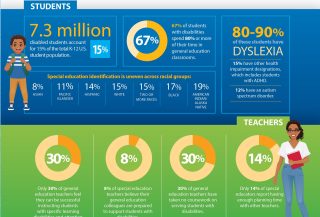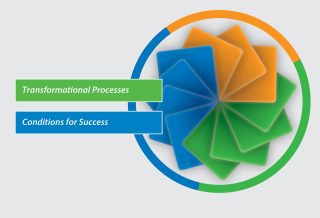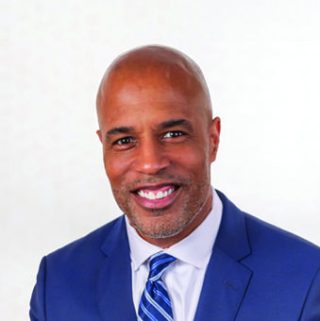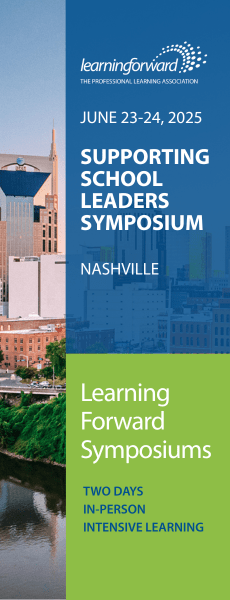FOCUS
Curriculum and instruction take a front seat in professional learning
By Jess Barrow and Eric Hirsch
Categories: Implementation, Instructional materials/curriculum, Standards for Professional LearningJune 2022
Curriculum is an essential but often underemphasized factor in quality teaching and student learning. One part of the problem is that teachers have few opportunities to learn about and practice with curriculum even when their districts have selected high-quality materials.
Nearly a third of teachers have access to less than five hours of curriculum-related professional learning per year, and a quarter of teachers say they have no access to such learning at all (Doan et. al, 2021). This is shocking, considering the improvements curriculum developers have been making to instructional materials in recent years and the fact that teachers need support to leverage that content.
Learning Forward, which since 1994 has created and supported the use of comprehensive professional learning standards, is encouraging education leaders to change the longstanding pattern of ignoring curriculum and instead put curriculum at the center of teacher learning and support.
The recently revised version of Standards for Professional Learning (Learning Forward, 2022) includes an important shift toward centering rigorous content for each student, including a foundational focus on curriculum, assessment, and instruction. (See box on p. 58.) This shift reflects the current landscape of academic standards, available high-quality instructional materials, and the wealth of research that indicates the impact of quality content in the hands of great educators.
This shift aligns closely with the work of our organization, EdReports. Since 2015, EdReports has provided independent reviews of K-12 instructional materials to support educators to identify, select, and demand the highest-quality curriculum. We also partner with districts and states to encourage best practices for curriculum adoption and implementation. We see professional learning as a critical factor for achieving the full potential of high-quality curriculum and instructional materials.
EdReports’ executive director, Eric Hirsch, has been involved with multiple revisions of Learning Forward’s Standards for Professional Learning, most recently as a Standards Advisory Council member for the recent fourth iteration. Hirsch shared his thoughts on the importance of content in professional learning standards with Jess Barrow, EdReports managing editor. Hirsch explained how the curriculum field has changed over the past decade, how that informed the new standards, and how educators can get access to the resources they deserve.
Why are professional learning standards, especially those tied to curriculum, assessment, and instruction, important for student learning and success?
Academic standards allow us to be clear about what a student needs to know and be able to do. Professional learning standards support educators, districts, and states to understand how teachers should learn and grow in the profession and best practices for helping them develop that knowledge.
Standards for Professional Learning help answer two interrelated questions: What does it look like to build a system that ensures teachers are able to learn from each other to do their best work and therefore put student learning first? And what does it take to invest in professional learning for adults — not just financially, but in terms of capacity?
Including curriculum, assessment, and instruction as integral to professional learning matters more now than in the past, given where we are with our understanding of the role instructional materials play in preparing all kids for college and career. That’s why the instructional core (Elmore, 2008) is now placed directly into the Curriculum, Instruction, and Assessment standard. The focus is on the content students are learning, the teachers who are conveying that content, and the resources, supports, and strategies guiding instructional choices.
How has the curriculum field evolved since the last iteration of Learning Forward’s Standards for Professional Learning, and what does this mean for educators?
So much has changed over the past decade since the last version of Standards for Professional Learning. That’s one of the reasons I appreciate Learning Forward’s commitment to continuous growth and learning as an organization, including regularly revising the standards.
Among the things that have changed, there is a wealth of published research that conveys the impact of high-quality instructional materials on student learning (EdReports, n.d.a). In addition, almost every U.S. state has adopted college- and career-ready standards. Over the past seven years, materials have improved to meet those standards. EdReports has documented the availability of dozens of quality, aligned programs (EdReports, 2021).
Given the improvements we’ve seen, materials are strong enough now to be a foundation for professional learning in a way that was impossible a decade ago. We have the kinds of resources that teachers deserve and should be using. That means professional learning should help educators with content and pedagogy while providing guidance on how to apply them within the scope and sequence of a strong curriculum.
How has the standards revision process made Standards for Professional Learning more relevant for today’s classrooms?
I think one of the biggest and most meaningful shifts we’ve seen with the revision and development of the new standards is prioritizing what a teacher should know. The previous standards primarily emphasized how to create systems that support teachers to learn and improve, including aligning staff schedules to allow for collaborative learning and providing resources and leadership for professional learning.
All these components that are about the how are important. But the what of the learning is also important, and the previous standards didn’t necessarily elevate the content of what a teacher should know or the materials they should use effectively.
Through this revision process, the standards designers were able to preserve critical elements of the how while adding a significant emphasis on the what. The new standards incorporate what we’ve learned about curriculum content, the quality of curriculum in the market, and the impact great content has on teachers and students.
As a result, these standards are more relevant for today’s classroom because they talk about what teachers do in the classroom — building students’ content knowledge. Ultimately, school is about putting a teacher and students together and engaging students in learning and growing. The standards in the Rigorous Content for Each Learner category (see box above) speak to that most essential learning bond and the role that professional learning plays in helping teachers develop it.
What recommendations do you have for district leaders who want to implement quality professional learning connected to curriculum learning?
We know that even though high-quality instructional materials are available, not nearly enough teachers have access to them. While over half of English language arts materials meet EdReports expectations for alignment with college- and career-ready standards, only 27% of English language arts materials used by teachers in classrooms are aligned (EdReports, 2022). In mathematics, 45% of materials meet our expectations for alignment, but less than a third of materials used by teachers in classrooms are aligned (EdReports, 2022). The discrepancies between what’s available and what’s in use are a clear signal to school, district, and state leaders selecting and implementing curriculum that better choices can be made.
Districts must invest in high-quality instructional materials and select them through a comprehensive adoption process that engages educators and plans for implementation, including assessment and professional learning (EdReports, n.d.b). Selecting quality materials is time-intensive and involved, but curriculum leaders have a variety of resources to support a choice that will align with a district’s instructional vision, the professional needs of teachers, and, most importantly, the learning and cultural needs of students.
It’s easy to assume that the tough part is over once a new program has been selected; however, establishing access to curriculum-specific professional learning has the potential to make or break the hard work that a district has done to improve the instructional materials available for its students.
If teachers are to “understand curriculum and implement through instruction,” as the Curriculum, Assessment, and Instruction standard specifies, district leaders have just as much responsibility to provide support on how to use rigorous content as selecting the rigorous content itself (Learning Forward, 2022).
What about recommendations for instructional coaches, principals, and others who facilitate professional learning?
Involvement and support from principals and instructional coaches is critical. Recent data suggests that when teachers have the encouragement of school leadership, they are more likely to use high-quality, aligned materials (Doan et. al, 2021). The same is likely true for upholding professional learning standards. A supportive environment can go a long way toward shifting culture and practice.
My first piece of advice is for leaders to prioritize the voices and needs of educators in your materials selection process and the professional learning communities implementing curriculum. It all starts with really listening to teachers because they are the ones using the curriculum.
They need to understand why the materials are (or are not) high quality, what adaptations and supplements may be needed, and how assessments can inform their instructional decisions as they strive to reach students at all levels of learning. This is emphasized in the Professional Expertise standard.
Coaches play an integral role in understanding and supporting teachers’ needs, too. Coaches know when and how to lean in (or lean out) and can work closely with teachers on how the materials help all kids to meet the demands of student academic standards. Where the curriculum hasn’t given enough support or guidance or where students may face unfinished learning, coaches can step in to facilitate teacher learning that fills those gaps.
Second, principals and coaches have the benefit of seeing how materials are used across classrooms, and they can use that knowledge to fill gaps and build consistency. They also have a deep understanding of school-level data and academic standards that can be applied to support teachers to use the curriculum and ensure students are receiving the right content at the right time in the right amount.
In fact, the importance of prioritizing coherence and alignment is built into Standards for Professional Learning (Learning Forward, 2022). Rather than expecting teachers to piece together that kind of coherence lesson by lesson and classroom by classroom, a supportive environment helps ensure all students are accessing the content they need — not just on a daily basis, but year after year.
Third, instructional leaders should support teachers to problem-solve and address student-specific needs. Students have individual needs and arrive in classrooms at different levels of learning. Instructional leaders can be great thought partners and facilitate educator collaboration to support teachers with questions like: What can you do differently if a student is struggling with the content in the curriculum or if a student is excelling and needs more challenge? Standards for Professional Learning remind leaders to use evidence and data from multiple sources to plan and monitor their learning and assess its impact on students to make the most of classroom content (Learning Forward, 2022).
What role can teachers play in the process of adopting and implementing high-quality curriculum?
My first piece of advice to teachers is, if you have access to a high-quality curriculum, use it. Instructional materials matter. If all teachers are using high-quality curriculum, then all students have access to the content that can make a difference for them in school and beyond. Plus, teacher time is freed from searching for or creating materials and redirected to inspiring a love of learning for every student.
But sometimes teachers don’t see these benefits. For example, some may see district-provided materials as a script that leaves no room for autonomy. That’s where professional learning comes in. Professional learning can and should highlight why materials matter, the hallmarks of a strong curriculum, and resources that support teachers in identifying the strengths and gaps in their materials.
Standards for Professional Learning spell out these expectations, not just in the Curriculum, Assessment, and Instruction standard, but in the Professional Expertise standard, which specifies that professional learning should support teachers to understand what makes a program or practice high quality. This is also true of the Equity Practices standard, which can help educators consider whether and how instructional materials represent the diversity of voices, perspectives, and experiences of the students they teach.
Second, I recommend that teachers advocate for high-quality materials and curriculum-specific professional learning if their district has not invested in them. It’s the school district’s responsibility to provide all educators with high-quality, aligned materials and ongoing professional learning to implement those materials well. But we know this doesn’t always happen.
Educators without access to district-provided high-quality instructional materials can focus on building their collective capacity to strengthen what they have, adapt free resources they identify as high-quality, and create curriculum materials as needed to ensure student access to essential content. But these solutions are not only challenging to develop and implement well — they are also temporary.
For long-term, sustainable change, teachers must advocate for the materials and curriculum-focused professional learning they deserve. The standards can help teachers make the case by pointing out that conditions for success include a commitment to systems and supports that build individual and collective capacity. Once teachers develop their professional expertise around curriculum, they’ll be in a better place to effectively propose changes when materials or professional learning don’t meet the mark.
Having the knowledge and skills to advocate for the materials their students need can make a difference in getting access to these resources (Arabo, 2019). A few important questions that teachers should ask are: What are we selecting next? What will the process look like? Why aren’t we selecting now? How can we use our Elementary and Secondary School Relief (ESSR) funds to procure quality curriculum for all (Hirsch & Weisskirk, 2021)? What does our implementation and professional learning plan look like? What standards are we holding our professional learning to?
With more options available than ever before, educators can harness their power and expertise to move states and districts in the right direction for their school community (Lebel, 2019).
A step forward
The revised Standards for Professional Learning are an important step forward for ensuring all students have access to rigorous content and that all teachers know how to teach it. A recent paper released by the Carnegie Corporation of New York argues that innovations in professional learning have not been keeping pace with evolving expectations for teachers, the instructional materials they are using, and the rigorous content standards teachers are responsible for helping students meet (Short & Hirsh, 2020). The revisions in Standards for Professional Learning aim to address that gap by meeting the needs of teachers as they strive to inspire a love of learning and prepare all students for college and career.
The body of research and data on the impact of high-quality instructional materials is clear: Curriculum choices matter. But how teachers use curriculum matters even more.
Access to professional learning and the standards for ensuring that these are high-quality learning opportunities have never been more important. Teachers deserve these resources. Studies tell us that it makes sense to provide curriculum at scale and that professional learning is key to successful implementation. Only then can we hope for impact to reach all classrooms.
Download pdf here.
Standards for Professional Learning: Rigorous Content for Each Learner
Professional learning results in equitable and excellent outcomes for all students when educators …
Equity Practices
… understand their students’ historical, cultural, and societal contexts, embrace student assets through instruction, and foster relationships with students, families, and communities.
Curriculum, Assessment, and Instruction
… prioritize high-quality curriculum and instructional materials for students, assess student learning, and understand curriculum and implement through instruction.
Professional Expertise
… apply standards and research to their work, develop the expertise essential to their roles, and prioritize coherence and alignment in their learning.
References
Arabo, M. (2019). 5 ways teachers can advocate for better materials. EdReports.org. www.edreports.org/resources/article/5-ways-teachers-can-advocate-for-better-materials
Doan, S., Fernandez, M., Grant, D., Kaufman, J., Setodji, C., Snoke, J., Strawn, M., & Young, C. (2021). Instructional resources surveys: 2021 technical documentation and survey results. RAND Corporation.
Elmore, R. (2008). Improving the instructional core. Harvard University School of Education.
EdReports. (n.d.a). Why materials matter. Author. www.edreports.org/impact/why-materials-matter
EdReports. (n.d.b). Selecting for quality: 6 key adoption steps. Author. www.edreports.org/resources/adoption-steps
EdReports. (2021). 2020 state of the market: The use of aligned materials. Author. www.edreports.org/resources/article/2020-state-of-the-market-the-use-of-aligned-materials
EdReports. (2022). 2021 state of the market: The availability and use of aligned materials. Author.
Hirsch, E. & Weisskirk, L. (2021). Invest in quality curricula now for long term returns. EdReports.org. www.edreports.org/resources/article/invest-in-quality-curricula-now-for-long-term-returns
Learning Forward. (2022). Standards for Professional Learning. Author.
Lebel, S. (2019). How I used EdReports to advocate for high-quality materials. EdReports.org. www.edreports.org/resources/article/how-i-used-edreports-to-advocate-for-high-quality-materials
Short, J. & Hirsh, S. (2020). The elements: Transforming teaching through curriculum-based professional learning. Carnegie Corporation of New York.
Categories: Implementation, Instructional materials/curriculum, Standards for Professional Learning
Recent Issues
LEARNING DESIGNS
February 2025
How we learn influences what we learn. This issue shares essential...
BUILDING BRIDGES
December 2024
Students benefit when educators bridge the continuum of professional...
CURRICULUM-BASED PROFESSIONAL LEARNING
October 2024
High-quality curriculum requires skilled educators to put it into...
LEARNING TO PIVOT
August 2024
Sometimes new information and situations call for major change. This issue...














